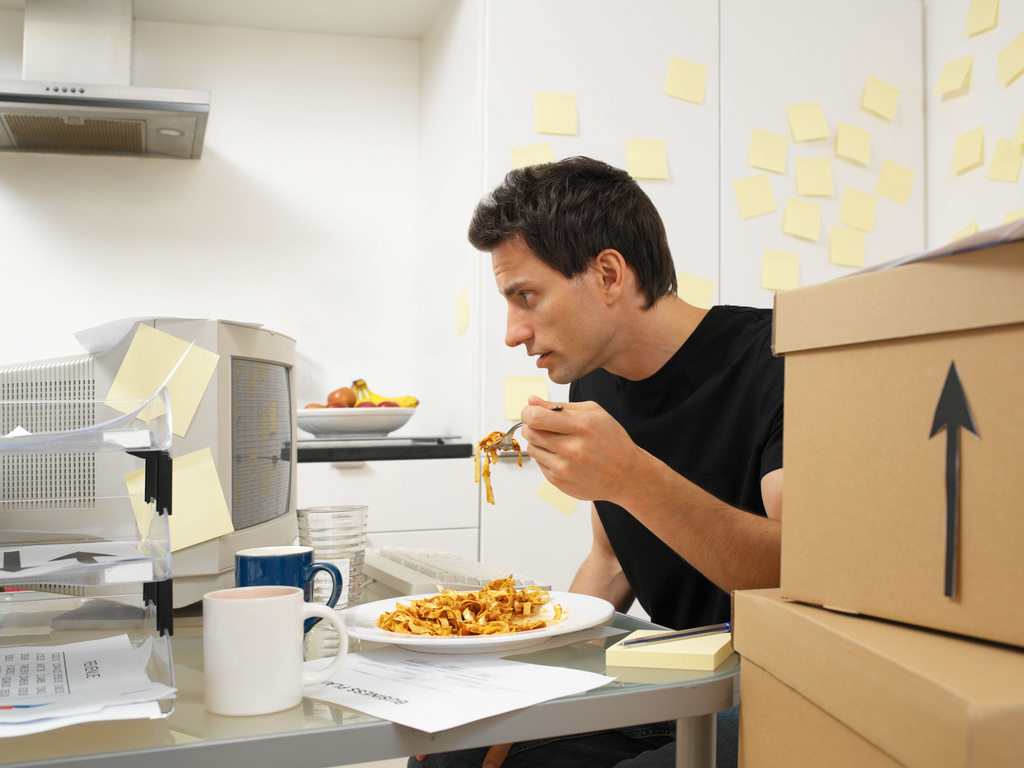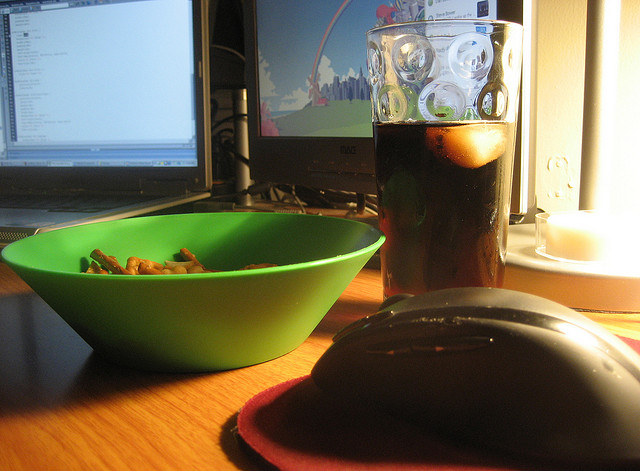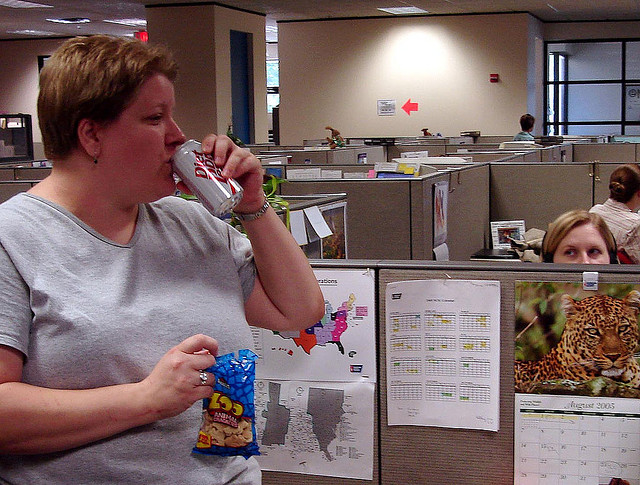Mindless Eating at Work: Put Down the Bag of Pretzels & Step Away From Your Desk
If portion control is key to weight loss success – as much of the current research on American diet suggests – then what determines how much we eat?
It’s not always hunger, which won’t come as groundbreaking news to anyone who’s sat at their desk with an open bag of pretzels, only to look down ten minutes later and discover with surprise that half the package has vanished. Environmental eating cues, from the size of our plates to the background music we hear, can have a substantial impact on what we eat. Unfortunately, this is especially true when it comes to eating at the office, when we might have less control over our environment than we do at home. There are a few things to keep in mind, however, that will help you make better choices while you’re eating at work.

Image source: flickr user Victor1558
When you start looking into the science behind portion control, one name comes up over and over in articles and studies: Dr. Brian Wansink. As the head of the Food and Brand Lab at Cornell University, Wansink has conducted numerous experiments that demonstrate how powerful environmental effects can be. In one oft-cited study, movie theater attendees who were given giant buckets of popcorn ate almost 175 calories more on average than people given smaller buckets – and almost everyone ate a considerable amount, even though the popcorn was five days old. Wansink is also the mastermind behind the infamous “bottomless” soup bowl experiment, where a specially engineered self-refilling soup bowl led restaurant diners to eat nearly 75 percent more soup (and calories).
Wansink’s research has clearly identified numerous factors that contribute to what he calls “mindless eating”: the kind of eating that occurs not due to hunger, but the power of convenience and subconscious cues. As Wansink tells the Boston Globe, “”The big danger is that we all think we are too smart to be influenced by environmental cues.”
Luckily, Wansink has also made it a focal point of his career (and a fair amount of books sold) to provide practical advice on how people can overcome these environmental cues and improve their eating habits. So, how can the average American put Wansink’s wisdom into practice when it comes to eating at the office? For starters…
Don’t eat out of a bag or box. When you’re reaching into a bag of chips or box of crackers, there’s no cue to signal when you’re done – so you’re more likely to keep munching away. Wansink advises that we should always put a portion of a snack on a plate, and put the bag back in the cupboard. Rather than keeping a big bag of snack food on your desk, portion a reasonable serving size into a baggie and leave the larger package in the kitchen (or at home).

Image source: flickr user Jayeb333
Choose a smaller plate. Over the last few decades, the size of the typical dinner plate has expanded along with Americans’ waistlines. Wansink reports that when we eat off a salad plate instead of the typical 12-inch dinner plate, the average person eats 22 percent fewer calories. Even if the break room is stocked with dinner-size plates, keep a smaller one on hand for your own use.
Don’t make lunch a multi-tasking event. For the same reasons Wansink and other experts advise not to watch TV while you eat, you shouldn’t eat while you work at your computer. You won’t be paying attention to your internal cues, like satiety and pleasure, and you’ll end up eating more food while enjoying it less. This is why offices should prioritize having a separate break room for meals: getting away from the desk to eat not only affects employees’ ability to practice portion control, but will boost mood and concentration levels throughout the day.
Start with salad, vegetables, or fruit first. When the office has a catered buffet lunch or decides to share family-style takeout, make a beeline for the salad or vegetable dishes before you hit up the meat and potatoes. Wansink’s research shows that we eat more of what we’re offered first – in one experiment, when fruit was offered first at a breakfast buffet, almost everyone (86 percent) took some. When it was offered last on the line, just over half (57 percent) added fruit to their plates.

Image source: flickr user katedahl
Be a trendsetter, not a follower. Peer pressure affects our eating habits, too. We’re more likely to order fries if our dining companions do so first, and the same goes for salad. So when it’s time to collect the lunch order, be bold about choosing a healthy takeout dish like brown rice, veggies, and omega-3 rich salmon instead of a cheeseburger or pizza. You might not only improve your diet, but your coworkers’ as well.
Leave the mindless vending machine lunches behind. With Waiter.com‘s easy online ordering and quick delivery, lunch can once again become an occasion to socialize with coworkers and truly enjoy a delicious, nourishing meal – without ever leaving the office.